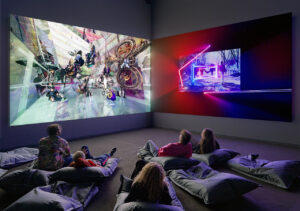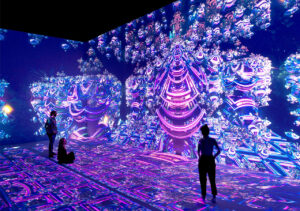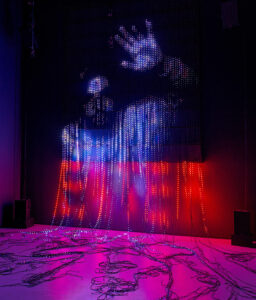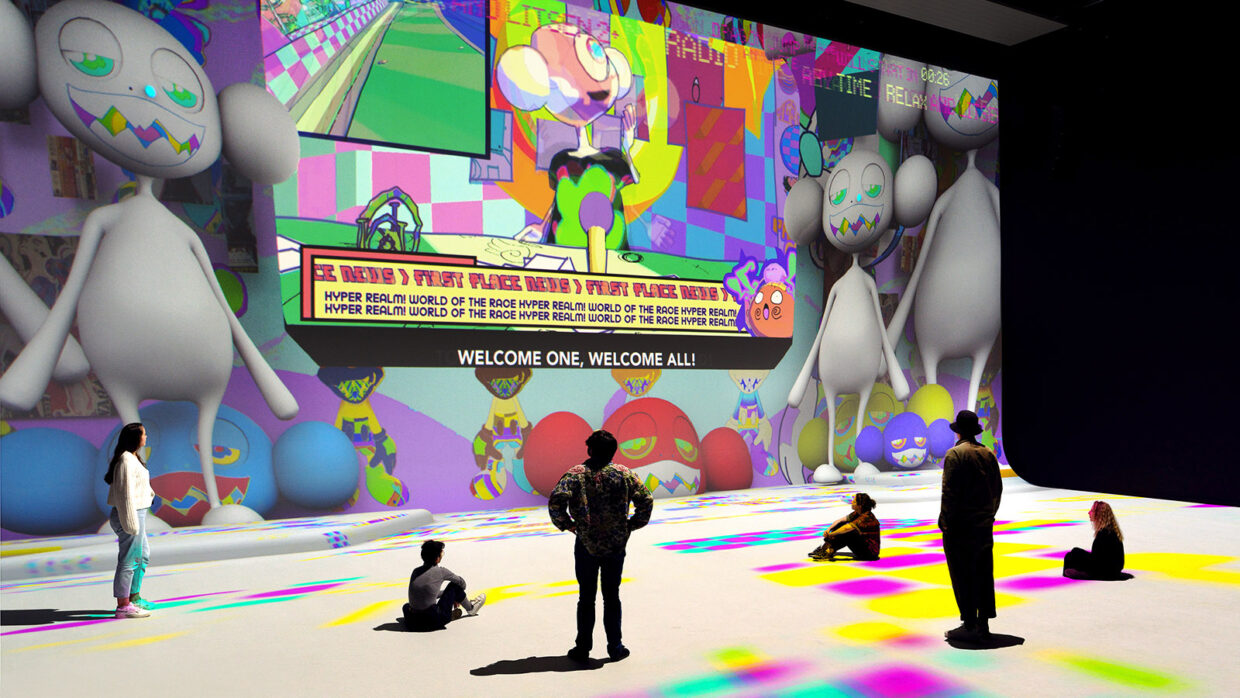Fitting for a new museum centering new media, Nxt Museum’s current exhibition is fully of the moment. As Web3 increasingly fixes itself in cultural conversation, UFO – Unidentified Fluid Other interrogates our digital future, imagining how identity might be newly fluid on the virtual plane. It features the art of Jacolby Satterwhite, Harriet Davey, and The Fabricant, among other creators whose multimedia works survey “the early tremors of our approaching digital existence.”
Running until August 2023, UFO further invites audiences to participate in the Web3 enterprise. Hidden throughout the exhibition are three QR codes, which, when scanned, would allow visitors to unlock and collect free Proof-of-Attendance Protocol badges (POAPs). Minted on the POAP platform, these digital tokens denote attendance or participation in specific events or interactions, while serving as a blockchain-based memento. UFO’s POAPs have been designed by the exhibition’s participating artists, and can be stored in a crypto wallet like Rainbow or on the POAP app, or accessed through a browser.
“It’s a very approachable way to collect a really nice memory of your journey or of your favorite artwork,” says Merel van Helsdingen, Founder and Managing Director of Nxt Museum. “We’re not asking people to download a wallet or pay in any cryptocurrency; it’s a very low-threshold model to start diving into Web3.”

The museums’s second exhibition, UFO features multimedia works that examine “the early tremors of our approaching digital existence.” Image: Birds in Paradise by Jacolby Satterwhite, part of UFO — Unidentified Fluid Other, 2022 / photography by Gert Jan van Rooij
As soon as NFTs made the scene, cultural organizations have variously involved themselves in the medium and technology — dropping NFTs, staging digital art exhibitions, hosting educational webinars — in a bid to engage the Web3 realm and audience. Museums, though, have left POAPs untouched, despite the potential the tokens represent to cultural venues that host regular events and are appended with a gift shop.
Launched over the pandemic, the Amsterdam museum has become one of the earliest (if not the first) cultural institutions to deploy POAP technology. It’s an integration that presents obvious opportunities to deepen interaction, but also, as van Helsdingen points out, to enhance engagement and storytelling.
Among the POAPs is what she terms a “Proof-of-Attention Protocol,” which requires visitors to answer a few questions about a specific artwork before they can collect the badge. “In a really fast-paced environment, where so much artwork is coming at you, sometimes the story or the purpose behind the work gets lost,” she explains. “We wanted to use this mechanism to bring people back into reading, listening, learning, and understanding.”

“We wanted to use this mechanism to bring people back into reading, listening, learning, and understanding,” says Nxt’s Merel van Helsdingen of the museum’s POAP implementation. Image: Foreign Nature by Julius Horsthuis, part of UFO — Unidentified Fluid Other, 2022 / photography by Gert Jan van Rooij
According to van Helsdingen, reception to Nxt’s POAPs has been warm enough to “start building our community and network of people who are interested in what we do.” She notes that these collectors are international, including visitors from the US and across Europe, and represent a span of POAP users. “There’s some really hardcore Web3 people who own 150 or 300 POAPs and there’s also a bunch of people who only own one,” she says. “That means that they came to Nxt to learn about Web3 and start their journey.”
Nxt itself is already making in-roads into Web3. POAPs aside, UFO also sees the institution launch its first NFTs, created by artists featured in the exhibition, including Harriet Davey and Julius Horsthuis, and available at the museum store. Next month, the museum will release yet more NFTs at Amsterdam Dance Event, where DJs will team up with artists to create immersive visual works. Minting will occur onsite at the event, “so you can mint the work that’s actually part of the show on the night,” says van Helsdingen.

Image: ENTER by Ksawery Kirklewski, part of UFO — Unidentified Fluid Other, 2022 / photography by Gert Jan van Rooij
The museum’s entry into NFTs and POAPs, she emphasizes, is the result of a considered approach, as opposed to “going in too fast with the wrong objectives.” Beginning in 2021, Nxt has hosted educational programs to shed light on NFT art and metaversal gameplay, allowing it to familiarize its audience with the blockchain, while observing and learning about the space. Web3, she adds, is bound to be a cultural mainstay, “a more prominent player” — and despite its decentralized ethos, there’s room enough for museums to participate and play a role.
“Institutions can build spaces or shows or relevance in virtual worlds. If it brings relevance for the museum visitor, then I think it’s great to test and see what happens,” van Helsdingen adds. “I am all for exploring what opportunities are in the future, but I do feel it should be in respect of artists, the artworks, and the story behind the work.”



